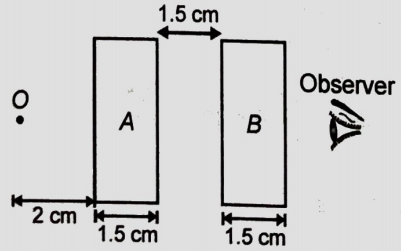A, B, and C are three optical media of respective critical angles . Total internal reflection of light can occur from A to B and also from B to C but not from C to A, then the correct relation between critical angles is
1.
2.
3.
4.
When a telescope is focussed for parallel rays then its magnifying power is 10 and the distance between the objective and the eyepiece is 22 cm. The focal length of each lens is
1. 20 cm, 2 cm
2. 11 cm, 9 cm
3. 10 cm, 5 cm
4. 18 cm, 2 cm
An object O is placed on one side of two glass slabs A and B of thickness 1.5 cm and refractive index 1.5. The position of the image of O, when viewed from the other side of slab B, will be:

1. 1 cm away from slab A
2. 1.5 cm away from slab A
3. 2 cm away from slab A
4. 2.5 cm away from slab A
The focal length of an equiconvex glass lens() in air is 20 cm. The relative refractive index of glass with respect to water is . If the lens is dipped in water, then its new focal length in water is-
1. 20 cm
2. -20 cm
3. 80 cm
4. -80 cm
A virtual image of an object is formed by a concave lens. The lens is then coupled (kept in contact) with a convex lens. A virtual image is again formed. Then the image, now
1. Shifts away from lens system
2. Shifts towards lens system
3. Remains at its original position
4. Data are insufficient to predict whether it will shift towards or away from the lens system.
A convex mirror of focal length f forms an image, which is times the length of the object. The distance of the object from the mirror is
1. (n - 1)f
2. f
3. f
4. (n + 1)f
We combined a convex lens of focal length with a concave lens of focal length and their combined focal length is F. The combination of these lenses will behave like a concave lens, if
1. >
2. <
3. =
4.
A ray of light is incident on an equilateral glass prism placed on a horizontal table as shown. For minimum deviation, a true statement is:

| 1. | \(PQ\) is horizontal |
| 2. | \(QR\) is horizontal |
| 3. | \(RS\) is horizontal |
| 4. | Either \(PQ\) or \(RS\) is horizontal |
Minimum angular magnification produced by an astronomical telescope having a focal length of field lens and ocular 200 cm and 5 cm respectively is
1. 10
2. 20
3. 30
4. 40
The size of the image formed by a convex lens is one-fourth os the size of a real object. If the focal length of the lens is 30 cm, then the distance of the object from the lens is
1. 150 cm
2. 120 cm
3. 90 cm
4. 60 cm






